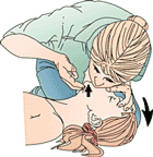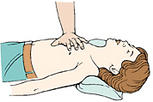CPR in children older than 12 months
What is CPR?
CPR stands for cardiopulmonary resuscitation. This is the lifesaving measure you can take to save someone who shows no signs of life (consciousness or effective breathing).
CPR uses chest compressions and "rescue" breaths to make oxygen-rich blood circulate through the brain and other vital organs until emergency medical personnel arrive. Keeping oxygenated blood circulating helps prevent brain damage – which can occur within a few minutes – and death.
CPR isn't hard to do. Follow these steps:
Step 1: Check the child's condition.
Is the child conscious? Tap on the child's shoulder and call out. If she doesn't respond, have someone call the local emergency number. (If you're alone with the child, give two minutes of care as described below, then call emergency yourself.)
Swiftly but gently place the child on her back on a firm, flat surface.
Make sure she isn't bleeding severely. If she is, take measures to stop the bleeding by applying pressure to the area. Don't administer CPR until the bleeding is under control.
Step 2: Open the child's airway.
Tilt the child's head back with one hand and lift his chin slightly with the other. This will open his airway.
Check for signs of breathing for no more than ten seconds.
To check his breathing, put your head down next to his mouth, looking toward his feet. Look to see whether his chest is rising, and listen for breathing sounds. If he's breathing, you should be able to feel his breath on your cheek.
Step 3: Give two "rescue" breaths.

If the child isn't breathing, give her two breaths, each lasting just one second. Pinch the child's nose shut, place your mouth over hers, and exhale into her lungs until you see her chest rise.
If her chest doesn't rise, her airway is blocked. Give her first aid for choking, described above.
If the breaths go in, give the child two rescue breaths in a row, pausing between breaths to let the air flow back out.
Step 4: Do 30 chest compressions.
Kneel beside the child's upper chest. Place the heel of one of your hands on the child's sternum (breastbone) at the center of her chest. Place your other hand directly on top of the first hand. Try to keep your fingers off her chest by interlacing them or holding them upward.
To do a chest compression, push the child's sternum down about 2 inches. Allow the chest to return to its normal position before starting the next compression.
Do 30 chest compressions at the rate of 100 per minute. Count out loud: "One and two and three and...," pushing down as you say the number and coming up as you say "and." (The song Stayin' Aliveis the right rate!)
When you complete 30 compressions, give the child two rescue breaths (step 3, above). (Each cycle of chest compressions and rescue breaths should take about 24 seconds.)
Step 5: Repeat compressions and breaths.
Repeat the sequence of 30 chest compressions and two breaths. If you're alone with the child, call emergency or the local emergency number after two minutes of care.
Continue the sequence of chest compressions and rescue breaths until help arrives, you find an obvious sign of life, an AED (automated external defibrillator) is ready to use, the scene becomes unsafe, or you are too exhausted to continue.
Even if the child seems fine by the time help arrives, a doctor will need to check her to make sure that her airway is completely clear and she hasn't sustained any internal injuries.
Source: http://www.babycenter.com/0_first-aid-for-choking-and-cpr-an-illustrated-guide-for-child_11241.bc

